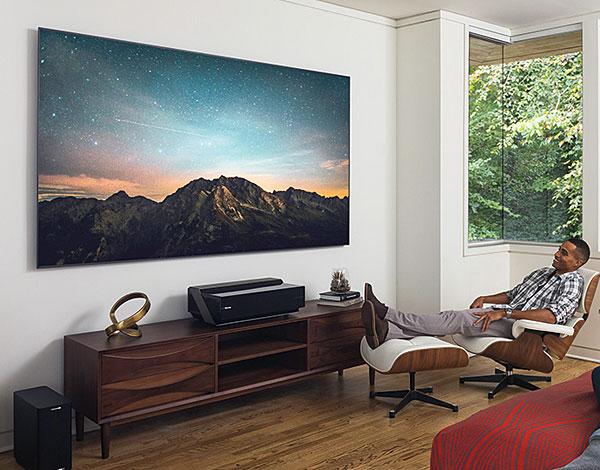Video Projectors—The Short (Throw) Story

The term “short-throw projector” is not well defined. A Google search turned up dozens of models, but with a few exceptions (primarily from Sony, Optoma, Epson, Hisense, and Wolf Cinema) they turned out to be business projectors with throws as short as 2 feet. That’s not what we’re looking for here. A home theater short throw projector should have a throw distance (projection-lens to screen) of no more than 18-inches. That’s the whole reason for such designsthe screen goes on the wall and the projector sits below it on a table or stand that’s virtually flush with the wall. With no projector hanging from the ceiling to deal with, the Wife Acceptance Factor (WAF) is through the roof. In fact, AV furniture maker Salamander Designs has just introduced an equipment rack specifically designed to house this type of projector. You can bet there’ll be more.
Some of these projectors come with a screen, which is typically up to 100-inches diagonal (Hisense demonstrated a 150-inch model at the 2018 CES, but it’s not yet available). These dedicated screens are often light rejecting.
Many of these models, for cost reasons, are currently limited to 1080p, though some can do 4K. The pricier ones can run to five figures (Sony just introduced the new 4K LSPX-A1, at $30,000). Most of them use DLP technology, which in our experience doesn’t offer the deeper blacks and richer contrast of the best LCOS (known as SXRD in Sony World) or LCD designs. All of them to our knowledge use laser illumination, which can last up to 20,000 hours and retain full brightness for a good stretch of that time, though industry experience to date with home theater projectors using laser illumination is limited. This is in contrast to the typical projection lamp that’s unlikely to last more than 6000 hours (and will grow progressively dimmer over its lifetime—a claim of 6000 hours doesn’t mean 6000 hours of like-new performance).
In order to accomplish this short throw exercise the image coming out of the projector must be pre-distorted to counteract the fact that it isn’t equally distant from all parts of the screen. This warp-distortion can be performed either optically or electronically (or perhaps some combination of the two). In theory, at least, using optical warping would be best, since it should retain most of the resolution in the source. Electronic warping can alter the resolution, making it different in different parts of the screen.
We’re still very much in the early-adopter stage of these devices, meaning that they should improve dramatically in the next few years. Whether or not that will allow them to compete with the ever-lessening prices of increasingly bigger flat screen sets is an open question. My experience with them is limited to CES and CEDIA demos, but based on those I’d have to say that while they can look very good they can’t, in my opinion, as yet equal the performance of a good conventional projector and screen in a fully darkened room. But they have their appeal.
If you’re in the market for one now here are several questions you should ask before pulling out your credit card.
1. Does it use laser illumination?
2. Is the laser replaceable in case of failure (how long is the warranty?) or if its claimed lifetime is up. (Although 20,000 hours is almost 14 years at 4 hours per day, which is probably long after you’ve replaced the projector, what if the laser fails at 5,000 hours and the display is out of warranty. Do you have to buy a brand new projector? From that perspective, a $400 replacement of a conventional projection lamp on a conventional projector starts to look pretty good.)
3. What’s the minimum throw distance (as noted earlier, it should be no more than 18-inches).
4. What’s the resolution? 2K? 4K? And if 4K, is it true 4K or pixel-shifted 4K. (All of the DLP models we know of are the latter.) And if its DLP, can it do P3 colorso far we know of no DLP model that can do soand at least make some attempt at HDR.
5.M Is the screen included, and if so, is it light-rejecting? Size?
6. Is the image-warping technology optical or electronic (this one is almost guaranteed to reduce the average salesman to tears).
Two more important points:
1. Don’t expect spectacular contrast, particularly in room lighting that might not faze a comparably priced flat screen set. A projector is still a projector. It does not project blacks, which means that black areas of the screen can never be darker than the screen looks under the same lighting conditions with the projector turned off. A light rejecting screen can help a little, but only if the light comes from the sides, not directly facing the screen such as from a window behind the seating area. Any advertising photos you might see of a happy couple sitting in a bright, sunlit room viewing a rich, high contrast picture are invariably Photoshopped (the photo at the top of this blog is a perfect example, but at least the room light is from the side). Be sure to get a real demo of the projector, if possible, in both the sort of room lighting you might expect to use and also in a totally darkened room.
2. Look out for the rainbow effect, an issue with most DLP home projectors. Some viewers are sensitive to, some are not. If you (or someone in your family) are, once you spot it you’ll find it distracting at best and incredibly annoying at worst. The rainbow effect appears as instantaneous flashes of multiple colors, visible most often near bright, moving objects against a dark background. You might not see it with sports, but might well on movies.


























































